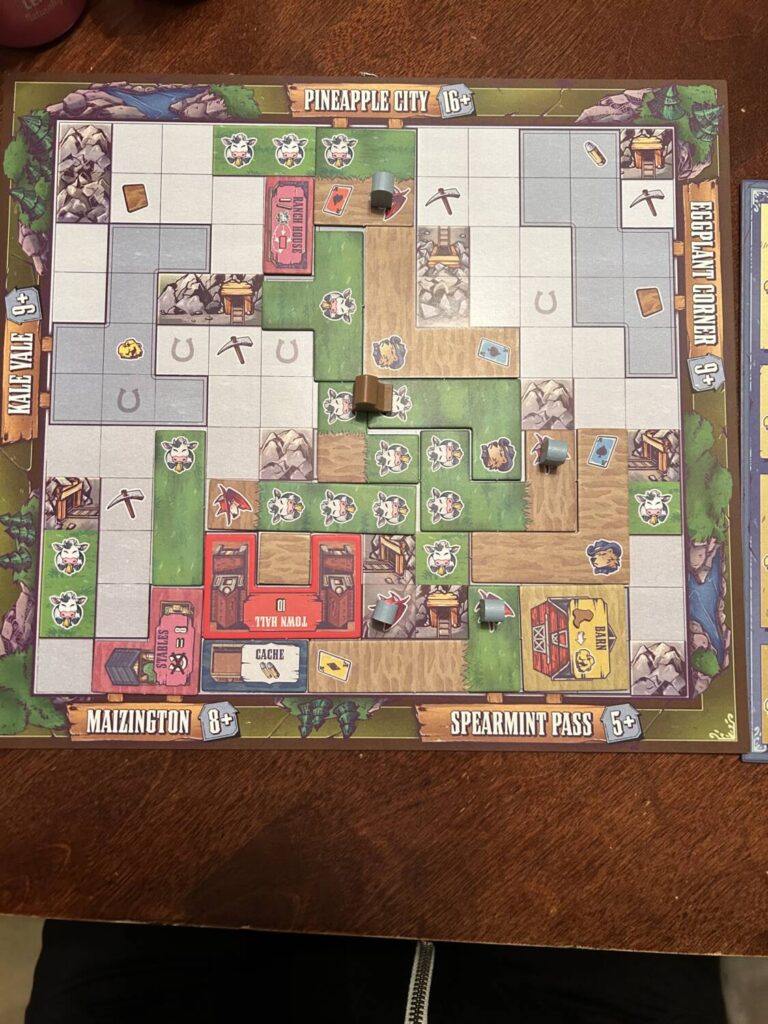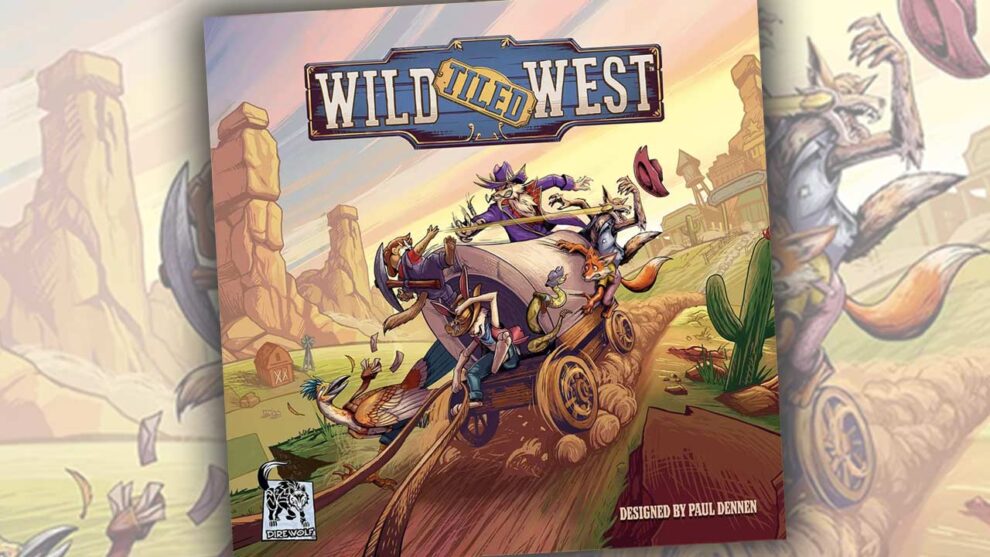Saddle Up
Designer Paul Dennen has won my trust with his design work on Dune: Imperium (and the recently released Dune: Imperium – Uprising), the Clank! games (Clank!, Clank! In Space, and their associated expansions). Publisher Dire Wolf first caught my eye with the digital card game Eternal and has continued to put out fantastic digital implementations of some of my favorite board games. I had to pry myself away from a challenge run of the Root digital adaptation to force myself to finish some work today. So when I heard Dennen was releasing a brand-new game under a new IP, I was immediately intrigued.
Wild Tiled West is, as the name implies, a Wild West-themed polyomino tile-laying game. Players will throw dice and take turns drafting tiles to add to their growing settlements, adding pastures, roads, and buildings to complete towns or fulfill certain scoring conditions. By covering specific grids, players will receive resources that help them buy fancier buildings or take out the ne’er-do-wells lurking among their towns. After four “years” of drafting, players will score up their settlements, and the person with the most points wins!
It may sound straightforward, and that’s because it is. But is that simplicity a strength or a weakness?
Fur-ocious Fun
The first thing to address is something that mostly comes down to a matter of taste, and that’s the choice to use anthropomorphic animals as the primary characters in the game. Don’t get me wrong, some of my favorite games have used this theme to significant effect (hello, Root), so it’s not an automatic dismissal. Perhaps it’s fatigue, then, that made me wish this game had just been a classic Western theme without the need for cutesy animals everywhere. In the last few years, I’ve played the Libertalia: The Winds of Galecrest reimplementation that traded swarthy pirates for animals. I’ve seen Zoo Vadis reimplement Quo Vadis? with the same swap. Honey Buzz was all the rage in 2020, Flamecraft was the hot new game in 2022, and then Apiary was all the buzz at the end of last year. That’s not to mention the hundreds of new games that don’t break into the zeitgeist. All this is to say: Can we find a new theme, please?
Cute woodland animals are an easy, family-friendly sell for a broad audience. Sometimes, they work to lighten the nature of the material, such as Root using animal factions modeled after real-life states and power structures. But did the Preacher in Wild Tiled West need to be a bird? Did the bandits need to be foxes? And what does all of this mean when cows are a resource to be farmed in-game?

That being said, the art is gorgeous. The team of artists for this game put much love and care into making this world come alive like a living cartoon. Upon playing this game with some friends of mine who aren’t avid board gamers, one of them couldn’t help but comment that it was apparent this game was created by people with a passion for visual design. That is, after all, a hallmark of Dire Wolf games. The dual-layered boards that hold all the tiles are nice and sturdy, the blue and green dice are easy to see at a glance, the cowboy boot meeples and gold nugget resources are fun, and in my favorite bit of functional design, the bullets your sheriffs use to kill baddies simply turn on their side to become tombstones instead. The box offers an elegant storage solution to simplify clean-up and enable you to start your next game in under two minutes. I’m simple: I see pretty storage options and am satisfied.
Rootin’, Tootin’, and Bandit Shootin’
If you’ve played any polyomino games before, you probably have a vague idea of what to expect from a game of Wild Tiled West. Each player gets a unique player board with resources marked on them. Your first tile drafted must be placed on the X spot on your board; after that, any tile drafted must connect to your existing structure. Boards are also unique because they have five different “town” areas shaded in, and filling in those shapes nets you bonus points. Horseshoe symbols on each board represent crucial paths to cover, as any horseshoes left uncovered at the end will dock you points. Each player will also pick one of two randomly assigned “partners” for the game, which will determine your unique scoring bonus at the end. The Preacher, for example, gives bonuses for tombstones, while the Prospector offers bonuses for your mining operation.
The first player begins each drafting round by rolling dice, then assigns them to the tile trays. Green dice go on the “prairie” rows, numbered 1-20, while the blue dice go on the river columns, marked 1-8. These rolls determine what tiles are available for drafting each turn. Prairie rows only offer the tile closest to the board’s edge as an option. River spaces are unique because players can pay one gold piece to “skip” tiles on the river and take the next tile up instead. Some of the most valuable buildings are in the center of the river columns, incentivizing players to strike it rich to get access to those tiles earlier.

But how does one get rich? At the start of each of the four “years,” players will collect income based on how advanced their mining operation is. You can advance your mining income by claiming pickaxes to get more gold. Pickaxes are just one of the symbols you can collect, alongside alley tiles that let you cover one single square and bullets that let your sheriffs take out those nasty bandits hiding around your board (so long as they are in the same row or column and have line of sight).
Bandit management is Wild Tiled West’s best mechanic, as taking tiles with bandits on them means your settlement is at risk of being overrun. At the end of each year, there’s a “tussle,” where the player with the most living bandits loses points, while the player with the fewest bandits on their board gains points (and, for their efforts, even more bandits move into town). I already mentioned how I love that the bullets, once used, are rotated to become tombstones for the bandits. Everyone I’ve played with has latched onto that as something they find clever. Endgame scoring is a combination of points from tombstones, mining, buildings, partners, and sets of playing card symbols in your settlement. Subtract out your uncovered horseshoes, and that’s your final score. As I said, it’s pretty simple!
The Good, the Bad, and The Ugly
There are minor variants on the core game that are optional. There’s a solo mode that I didn’t try because I’m not a solo gamer, though I’ve heard positive things from people who do play solo. There are also “wild sides” to each settlement board that are tougher to play and offer asymmetrical rules or powers to build around. It’s nice to include them, and they are there as a difficulty option, so veteran players can still have a challenge even when playing with newbies. Those things are nice, but they’re window-dressing for the core experience.
After several playthroughs, Wild Tiled West has earned its spot in my library as my go-to polyomino game of choice. (My condolences to Isle of Cats.) What I appreciate about Wild Tiled West is how accessible it is. My playthroughs have been with heavier board gamers and people who don’t usually vibe with board games. While the crunchier gamers have said it was straightforward, they also admitted there was a certain charm to the game’s simplicity. However, there’s a compelling puzzle beneath the surface for more casual gamers. The various scoring parameters are pulling you in different directions at all times, and just when you think you have the perfect tile to cover the exact spots you need, the person before you will take it out. In my last game, I went for a heavy tombstone strategy, and every other player at the table systematically drafted the Chapel buildings before I could get them just to make sure I couldn’t score a ton of bonus points at the end. Brutal? Yes. Strategically valid? Yes. Thematic? Yes!

Though I wish the game weren’t yet-another-dang-cutesy-animals-game, it’s hard to fault it too much for following the trend of what’s working in the current zeitgeist. It’s also shockingly refreshing to have a normal-sized box with a normal-sized board game, especially one that packs up nicely. Sometimes, I don’t have the energy to spend 45 minutes setting up Eclipse when we have people over. It’s comforting to know I can reach for Wild Tiled West and have it from box to table in just a few minutes. The accessible 45-90 minute play time also helps ensure it hits the table time after time.
Despite the rough-and-tumble nature of the Western genre, this game is a pleasant polyomino-filled adventure with a little bit of everything for everyone. Time will tell if it has the staying power to be the go-to tile-laying game in my collection, but for now, I’m enjoying my time shooting bad guys and mining gold in the Wild Tiled West.












Add Comment